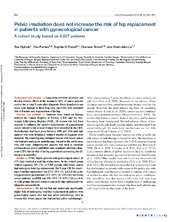| dc.contributor.author | Dybvik, Eva Hansen | en_US |
| dc.contributor.author | Furnes, Ove | en_US |
| dc.contributor.author | Fosså, Sophie Dorothea | en_US |
| dc.contributor.author | Trovik, Clement | en_US |
| dc.contributor.author | Lie, Stein Atle | en_US |
| dc.date.accessioned | 2015-08-05T13:12:44Z | |
| dc.date.available | 2015-08-05T13:12:44Z | |
| dc.date.issued | 2014 | |
| dc.identifier.issn | 1745-3674 | |
| dc.identifier.uri | https://hdl.handle.net/1956/10221 | |
| dc.description.abstract | Background and purpose — Long-term survivors of cancer can develop adverse effects of the treatment. 60% of cancer patients survive for at least 5 years after diagnosis. Pelvic irradiation can cause bone damage in these long-term survivors, with increased risk of fracture and degeneration of the hip. Patients and methods — Analyses were based on linkage between the Cancer Registry of Norway (CRN) and the Norwegian Arthroplasty Register (NAR). All women who had been exposed to radiation for curative radiotherapy of gynecological cancer (40–60 Gy for at least 28 days) were identified in the CRN. Radiotherapy had been given between 1998 and 2006 and only patients who were irradiated within 6 months of diagnosis were included. The control group contained women with breast cancer who had also undergone radiotherapy, but not to the pelvic area. Fine and Gray competing-risk analysis was used to calculate subhazard-rate ratios (subHRRs) and cumulative incidence functions (CIFs) for the risk of having a prosthesis accounting for differences in mortality. Results — Of 962 eligible patients with gynecological cancer, 26 (3%) had received a total hip replacement. In the control group without exposure, 253 (3%) of 7,545 patients with breast cancer had undergone total hip replacement. The 8-year CIF for receiving a total hip replacement was 2.7% (95% CI: 2.6–2.8) for gynecological cancer patients and 3.0% (95% CI: 2.95–3.03) for breast cancer patients; subHRR was 0.80 (95% CI: 0.53–1.22; p = 0.3). In both groups, the most common reason for hip replacement was idiopathic osteoarthritis. Interpretation — We did not find any statistically significantly higher risk of undergoing total hip replacement in patients with gynecological cancer who had had pelvic radiotherapy than in women with breast cancer who had not had pelvic radiotherapy. | en_US |
| dc.language.iso | eng | eng |
| dc.publisher | Taylor & Francis | eng |
| dc.relation.ispartof | <a href="http://hdl.handle.net/1956/10552" target="blank">Cancer and Total Hip Replacement. Cancer as a risk factor for prosthesis and prosthesis as a risk factor for cancer</a> | |
| dc.rights | Attribution CC BY-NC-ND | eng |
| dc.rights.uri | http://creativecommons.org/licenses/by-nc-nd/3.0/ | eng |
| dc.title | Pelvic irradiation does not increase the risk of hip replacement in patients with gynecological cancer. A cohort study based on 8,507 patients | en_US |
| dc.type | Peer reviewed | |
| dc.type | Journal article | |
| dc.date.updated | 2015-08-05T13:08:25Z | |
| dc.description.version | publishedVersion | en_US |
| dc.rights.holder | Copyright Nordic Orthopaedic Federation | |
| dc.identifier.doi | https://doi.org/10.3109/17453674.2014.963784 | |
| dc.identifier.cristin | 1195290 | |
| dc.source.journal | Acta Orthopaedica | |
| dc.source.40 | 85 | |
| dc.source.14 | 6 | |
| dc.source.pagenumber | 652-656 | |

